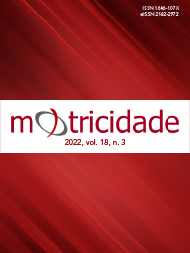Influence of physical fitness on the perception of physical well-being and quality of life in individuals with Intellectual Disability
DOI:
https://doi.org/10.6063/motricidade.25930Keywords:
Physical well-being;, Aerobic capacity;, Isokinetic strength;, Resistance;, Quality of life;Abstract
Physical capacities, health and quality of life (QOL) are improved through physical exercise in individuals with Intellectual Disability (ID). The aim of the present study was to verify the association of physical fitness with the perception of physical well-being and QOL in individuals with ID. Sixteen individuals with ID were evaluated by bioimpedance, functional tests (“6-minute walk test” (6MIN), “Timed Up and Go” (TUG), “30-s Chair Stand” (L/S), and “medicine ball throw”) and isokinetic dynamometer (lower limbs [LL]). The Personal Outcomes Scale (POS) was used to measure “Physical Well-Being” and “Total QoL”. Pearson and Spearman correlations were applied (p< 0.05). Correlations were found only in the female gender between the muscular strength in the extension/flexion of the LL (60º/s) and the responses of the reference technicians in the domains of “Physical Well-Being” (respectively, r= 0.729, p= 0.026; r= 0.802, p= 0.009) and “Total QOL” (respectively, r= 0.706, p= 0.033; r= 0.767, p= 0.016). It was found that strength, endurance and aerobic capacity do not seem to be associated with the physical well-being and QOL of the sample.
Downloads
Published
Issue
Section
License
The authors of submitted manuscripts must transfer the full copyright to Journal Motricidade / Sílabas Didáticas Editions. Granting copyright permission allows the publication and dissemination of the article in printed or electronic formats, and copyrights start at the moment the manuscript is accepted for publication. It also allows Journal Motricidade to use and commercialise the article in terms of licensing, lending or selling its content to indexation/abstracts databases and other entities.
According to the terms of the Creative Commons licence, authors may reproduce a reasonable number of copies for personal or professional purposes, but without any economic gain. SHERPA/RoMEO allows authors to post a final digital copy (post-printing version) of the article on their websites or on their institutions' scientific repository.


